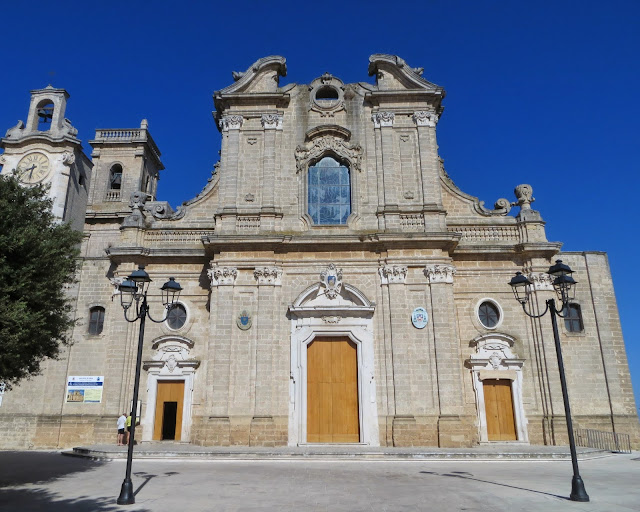An itinerary to visit Oria in Summer and to attend one of the most known events of the town. In this walking tour we'll discover and get lost among the beauties of the old town centre of Oria

In the past, it was among the richest and the most important centres in the area of Brindisi. Frederick II built one of his castles here, in order to control better his territories in Salento. It’s Oria, a little town that caught my attention with an event that is held in the second week of August, an event that calls all re-enactment and medieval joust lovers. I’ve been in Oria for the first time because I was attracted by this celebration, the Torneo dei Rioni (the tournament of the districts) and today I suggest you a little itinerary, a walking tour, to be added to this event, to dive in a highly engaging medieval atmosphere that you can breathe in the alleys of the old town centre.
1. The doors of the old town centre
For an organizational matter, I suggest to enter through the latter, so you can access directly Judea district, that is to say what once was the Jewish neighbourhood.
2. Judea district

The Jewish neighbourhood of Oria is particularly characteristic, with alleys that go up, down and intersect each other. It’s a real maze where you can indulge in the pleasure of getting lost and finding yourself again every time you turn and find a square with little nice balconies, a sign of the care of the inhabitants in the maintenance of the district. To underline the importance of the tournament in Oria, there are the banners hanging at regular intervals along the alleys: here there are those with the colours white and powder-blue as a background for a seven-branches candelabrum, representing Judea district.
As we explore the alleys of the neighbourhood, we walk towards the Cathedral.
3. The Basilica Cathedral Santa Maria Assunta
As we explore the alleys of the neighbourhood, we walk towards the Cathedral.
3. The Basilica Cathedral Santa Maria Assunta

The Cathedral shares the scene with the view that you can see from the parvis. At first there’s the Baroque façade, with its perfect spirals, then you look to right and, beyond the statue of the Stupor Mundi, you have an aerial view on the alleys of the old town centre. It feels like being a spectator who, from up there, looks at the inhabitants, who, unconscious of your presence, walk along the alleys busy in their everyday life. You turn towards the Cathedral and see the dome covered with polychrome majolica, which shine with their brilliant green and gold nuances under the morning sunshine.

The inside of the Cathedral is rich and refined: it’s decorated as any other Baroque church worthy of this style would and should be, but the colours of marbles and the powder shades of green and taupe of its environment, matched with golden details, give that touch of sophistication, elegance and solemnity.
4. The castle and Montalbano park

Those who are fascinated by Frederick II know that Oria hosts one of his castles. Unfortunately, it’s not accessible because it’s private, but it seems that there are some agreements between the City of Oria and the owner of the castle to open it to tourists. We’ll see in future if this mediation will bring the results hoped by those who, like me, can’t wait to visit it. Until that moment, we enjoy the outside with its three towers and its vessel shape.
According to me, the best place to admire it and , at the same time, to walk in a particularly nice green space of the town, is Montalbano park: an Italian style garden with paths, little bridges and little lakes. It’s the perfect place where to stay in tranquillity, enjoying the positive effects that nature gives, even though it’s built by humans. Besides, from here you can arrive just under the walls of the castle, so it’s the point where you have the possibility to get the closest to what at the moment you can see of the fortress. Also considering that this itinerary takes place in a summer day, you’ll be visiting Oria in a sunny day: the park is the ideal place where to shelter from the hot sunlight.
5. Il Torneo dei Rioni (the tournament of the districts)

Here the moment to attend one of the most known and loved events in Oria: the Tournament of the Districts with the historical re-enactment. The whole court of Frederick II parades and watches the tournament: the four districts (Judea, Castello, Lama and Santo Basilio) compete in the joust and in a contest of physical skills, for which their respective teams have prepared for the whole year. The spectacular is so engaging that you will find yourself, without realising it, to cheer for the contestants and to side for the district that will have conquered you sympathy. The participation to the joys and the efforts of your favourites in the tournament continues also at the end of the event, when the winner district celebrates the winning. The air of celebration is palpable. For this reason, I suggest to visit Oria in August, in correspondence of this event. It’s true, the hot climate of Salento in August makes itself felt, but the experience is worthy of every drop of sweat shed!
This is a little taste of Oria, a sort of preview that introduces and entices a second and more detailed visit. I already want to go back there to dedicate to it more time, to discover the other neighbourhoods of the old town centre and to make me involve by what this town offers to visitors.

Commenti
Posta un commento
Feel free to leave a comment!
I would be glad to know your opinion! ;)
Thank you! :)